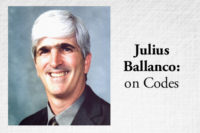Accolades go out to the International Code Council for www.cdpACCESS.com. This is the website used for all code-change activities.
While old-timers in the code business cursed it out a number of times, it has proven to be a very effective tool for improving the efficiency of the code-change process. Also, it opens the process to anyone.
If you have not signed up for for the ICC’s www.cdpACCESS.com, I strongly would encourage you to do so. There is no cost to sign up – it is merely that ICC needs to record your information to determine your voting privileges regarding code-change activity. Once on the site you can check out all the code-change activities. Plus, it allows you to search for the items that may be of interest to you.
Another reason for checking out the website is to see some of the video clips of the code-change hearing. ICC has inserted the specific video clip for each code change open for a floor vote. There are not that many in plumbing, but the few that are posted will give you a flavor of the code-change process.
If there is one change to review, I would encourage you to look at code change P233-15. I am not recommending it because I am the proponent and the first person to appear on the video screen. My reason is because the code-change video shows some of the back and forth that goes on, including three votes by the committee before it makes the motion to approve the code change. It also includes a procedure issue whereby a point of order is raised (by me). The point of order was accepted and additional testimony was provided.
If you are wondering what this code change was all about, it was a simple change to state that food-waste disposers shall not discharge through grease interceptors. This already is stated in the 2015 Uniform Plumbing Code. Of course, every plumbing engineer knows the worst thing you could ever do is discharge food waste from a disposer through a grease interceptor. The testimony points that out.
Food-waste removal
Unfortunately, this is one of those code changes where supposition is raised. There is the perception that any grease in food-waste particles will clog the public sewer system and foul up the sewage treatment process. I mention supposition because every study has proven this to be incorrect. Actually, food waste from a disposer has the equivalent amount of grease found in human excrement. But rather than reading the extensive and rather long studies, it is sometimes easier to make things up and guess.
If you do watch the video clip, you should be aware one of the individuals on the Plumbing Code Change Committee is an employee of a grease interceptor manufacturer. That manufacturer is one of the few grease interceptor producers that is not a member of the Plumbing & Drainage Institute. During testimony, PDI supported the change to prohibit food-waste disposers from discharging through a grease interceptor.
You will recall last month I mentioned there was a change related to reducing the height of the vent through the roof when a solar panel is installed over the vent. Later that week, the Residential Plumbing Code and Mechanical Code Change Committee had a similar proposal. That code change was accepted. Hence, the net result for one- and two-family dwellings and townhouses is the vent through the roof can be reduced when solar panels are installed. But, for commercial buildings the vent height cannot be changed. Expect a public comment to make the requirements consistent.
Contain the issue
A surprising change from the Code Action Committee was a proposal to require containment backflow protection for certain buildings with higher hazards. Containment is when the water supply has a backflow preventer on the inlet to the building. All plumbing codes have backflow protection based on point of use. This change received considerable discussion in opposition.
Philosophically, most opposed any change to the current concept. However, it was recognized that some water utilities require such backflow preventers as a means of adding protection to the public supply.
What appeared to be a simple change turned out to have a lot of discussion. The proposal was to allow sump pit covers to be located no more than 2 in. below grade or floor level. The current code requires the pit cover to be flush with the floor level or grade. The problem is the floor level sometimes changes. Additionally, some engineers prefer the cover to be located above the floor level. The code change was recommended for approval.
What would a code hearing be without discussions on air-admittance valves? Actually, the air-admittance valve changes were mild by comparison to previous years. One change prohibited an air-admittance valve from being used to reduce the clearance to an air intake opening. That has never been the intent of an air-admittance valve, even though it can work.
Perhaps the better approach would have been to require the vent terminal having an air-admittance valve to still be located a minimum of 10 ft. to an air intake opening. The code change to both the IPC and IRC was recommended for approval.
The other air-admittance valve proposed changes in regard to restricting the membrane material and the installation on a tubular trap connection were recommended for denials.
One of the last controversial plumbing code changes was to the Residential Code. The proposal would allow a sanitary waste valve to be installed in place of a trap. These devices often are called trapless traps. The valve is a short piece of elastomeric tubing that comes together in the middle to close off the opening. As a result, there is no water seal trap; the device is supposed to keep the sewer gas from entering a building. Of course, without a trap there does not have to be a vent since the vent protects the trap seal.
To those opposed, this device goes against the very heart of plumbing the water trap seal. The proponents presented the device as a great substitute for a trap and the future of modern plumbing.
The code change was recommended for approval by a split vote. All the inspectors on the committee voted against the change. The next step in the process is the public comment period, where anyone can submit a comment at www.cpdACCESS.com. All public comments will be discussed at the ICC Annual Conference Sept. 27-Oct. 6 in Long Beach, Calif.



